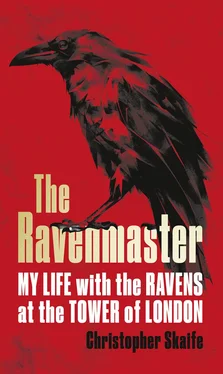To be honest, the answers all rather depend on what day of the week it is, but basically, if you keep setting ’em up, we’ll keep knocking ’em down.
Anyway, as I was saying, that’s basically the storeroom. Except, of course, for the dog biscuits. Bag upon bag upon row upon row of dog biscuits, all neatly lined up on the shelves. When people ask if they can come and see the ravens, or if there’s a group who want to come and talk to me about them, I have one simple request and requirement: that they bring with them a bag of dog biscuits. This is absolutely non-negotiable. I like to think that our ravens have the best diet of any birds in the world, a proper varied diet which keeps them strong and healthy. But everyone deserves a treat now and then, and the ravens love a nice dog biscuit soaked in blood. To prepare biscuits in blood, you simply place the dog biscuits into a container filled with blood and leave to soak for at least an hour – the longer the better. Et voilà! Bon appétit!
Rats are also a bit of a treat for the birds. I buy them in bulk from a specialist supplier and store them in the freezer. Then I get out as many as I need the night before, defrost them in the fridge, and prepare them in the morning. A nice fat rat’ll do a raven all day. A raven’s preferred method of engagement with a dead rat, or indeed with a live mouse if they get hold of one, is perfectly straightforward: foot on, claws in, beak engaged, guts first, then the rest stripped bare, leaving just the skin. All that usually remains is what looks like a mini rat-skin rug, which I like to bag up for the Tower foxes so there’s no waste.
A raven’s formidable claw. (Courtesy of the author)
The ravens get through about a ton and a half of food a year. Their diet mostly consists of chicken, lamb and pig hearts, liver, kidney, mice, rats, day-old chicks, peanuts in their shells, the occasional boiled egg, and some fish, steak chunks and rabbit (with the fur left on). Anything else they want, they steal from the bins and from the public, or they just go out and kill it. Most of the meat I get from Smithfield Market. If you’ve never been to Smithfield Market, you should go before it’s too late. It’s one of the great old London institutions, a proper wholesale market, but also open to the public, and always under threat of being re-developed and turned into swanky offices and fancy restaurants. Smithfield is not for the faint-hearted. I was a regular for about a year before any of the traders deigned to actually give me a nod, never mind speak to me. You can get amazing bargains, though only if you’re there by about 5 a.m. at the latest, and you’re prepared to buy in bulk. Whatever you do, don’t ask for a single lamb chop. Tell the lads there that I sent you. They’ll probably tell you where to go, but nonetheless, it’s a start. And once you’re there you might as well nip into the Hope for a pint, or La Forchetta for a cup of tea and a fry-up.
(Personally, I don’t like to eat until I’ve fed the ravens in the morning. This is not out of politeness. I don’t know if you’ve tossed many rats to a raven, or if you’ve ever had to clear up yesterday’s mauled meat leftovers, but from my experience you really don’t want to be doing so while digesting an early-morning bacon sandwich. Trust me, it’s best to go with a bowl of porridge once the job is over and done with.)
To be honest, I’d probably prefer if the birds were all vegetarian, but ravens, like a lot of us humans, are meat-eaters. There’s a theory that we Yeoman Warders got the nickname Beefeaters because as members of the royal bodyguard we were permitted to eat as much beef as we could from the king’s table. There are plenty of other theories about the origin of the nickname, but whether any of them are conclusive evidence I don’t know. Frankly, we all prefer to be called Yeoman Warders anyway.
Given a choice, I fancy that many of the ravens, like many of us, would probably survive on junk food. Merlina in particular is very partial to a crisp – or as Americans like to call it, a potato chip. She watches out for any little crisp that a young visitor might drop, and she’ll take it to one of the water bowls and give it a good rinse, softening it up for consumption. She has a particular ability to be able to spot a tube of Pringles from the other side of Tower Green, hop right up to an innocent member of the public, steal the whole tube, hop off with it, pop off the lid, and cram as many crisps into her mouth as she possibly can before being noticed. This is worth bearing in mind if you’re thinking of visiting the Tower and bringing a snack with you. Remember: ravens are opportunists, and will happily steal anything from you if and when the chance arises.
I have spent almost as many years now standing at my post on Tower Green watching the ravens getting into scrapes as I spent getting into scrapes myself in the army, and I can safely say that to watch a raven at work scavenging food is to witness something very much like a military operation. As a soldier you’re taught all sorts of drills and standard operating procedures to prepare for battle and to analyse your options when engaged on a mission. In military terms this is how we might describe one of Merlina’s typical sandwich-snatch operations:
MISSION: To steal a ham sandwich from a visitor sitting on a bench.
PLAN OF ATTACK: Sneak up from the rear with stealth and cunning, hide under the bench until the target puts down the sandwich, then remove the prize by pulling at it through the bench slats until in full possession. Then hop off.
ACTIONS ON: If detected on the approach to the bench, look innocent and peck at the ground.
ACTIONS ON: If member of the public isn’t putting the sandwich down, jump on the bench and scare them until they drop it.
ACTIONS ON: If unable to tug the sandwich through the bench slat, pull harder and store as much as you can in your mouth at the same time.
RE-ORG: Hop to the Ravenmaster for protection while you’re being chased by the angry visitor.
Whatever their personal snacking habits, I always feed the ravens twice a day in the enclosure, once in the morning and then sometime in the afternoon. Feeding them in the enclosure allows me to monitor what they’re eating. In the past the Ravenmasters preferred to put the food out around the Tower, but the problem was that a seagull might take a nice juicy piece of ox liver, say, that was intended for a raven, have a little nibble on it, and then casually drop it on a visitor from a great height. I’ve seen it happen more than once, and believe me, it is not a pretty sight. These days the ravens have come to expect to find food in the enclosure, and because they know they’re going to be fed safely there, they’re happy to roam around all day. It also encourages them to go back to the enclosure as the light fades. It’s a win-win.
In preparing the food, it’s important of course that we follow basic health and safety requirements. I am an absolute stickler for proper hand-washing procedures. Plus, I like the smell of all the antiseptic stuff. I can remember when I’d just started work at the Tower and the old Ravenmaster, Derrick Coyle, would walk into our guardroom, the Yeoman Warders’ Hall, and I could smell the antiseptic on him. It always reminded me of my childhood. The smell of my mum scrubbing up in the hairdressing salon where she worked, the smell of a day having been properly completed, or just begun. The smell of cleanliness, of preparedness, of a job well done.
Once I’ve distributed the food to the birds I leave them in the enclosure for an hour or so before letting them out. The great thing about ravens – unlike, say, us humans – is that they’ll only eat until they’ve had enough, and then they like to go off and exercise. Anything they don’t use they’ll cache.
Читать дальше












